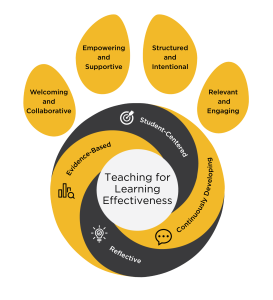About the Definition and Model
During the beginning of work by the Task Force to Enhance Learning and Teaching (TFELT) in 2019, establishing a definition of and model for Teaching for Learning Effectiveness emerged as a central priority. In order to develop a multi-measures teaching evaluation system that provides consistency and clear direction while maintaining flexibility to accommodate a wide diversity of disciplines, teaching modalities and pedagogies, the task force prioritized the creation of a common vocabulary and set of broad goals for Teaching for Learning Effectiveness grounded in the scholarship of teaching and learning in higher education. This effort is consistent with the consensus of scholarship on teaching in higher education: Teaching for Learning Effectiveness “requires a set of particular skills and practices as identified by research (Penny, 2003) and . . . meets the requirements of the context in which it occurs (Devlin, 2007a)” (Devlin & Samarawickrema, 2010).
This definition and model were developed and refined over a three-semester period. During this time the task force reviewed the research literature on teaching evaluation, as well as conducted numerous conversations and workshops with faculty, graduate students and undergraduate students across the university. Multiple iterations of the definition and components of the model were developed and revised based on qualitative data analysis of the contributions made during these various conversations. For more information on this process, please see the “TFELT Process to Determine Definition and dimensions of Effective Teaching” section on the task force’s online archive of in-progress work.
Defining “Teaching for Learning Effectiveness”
The TFELT definition of Teaching for Learning Effectiveness reads as follows:
At the University of Missouri, Teaching for Learning Effectiveness fosters student learning through evidence-based, relevant, organized, and engaging instruction. Effective educators use student-centered instruction to create learning environments so that all learners can be successful. Sustained Teaching for Learning Effectiveness requires continual refinement through deliberate reflection and professional development, and it is supported by institutional resources and programs.
Please note that elements of this definition are reflected directly in the various components of the accompanying model. The “pawprint model” consists of two distinct but interrelated sets of concepts: the Foundations and Dimensions of Teaching for Learning Effectiveness

Foundations of Teaching for Learning Effectiveness
The black-and-gold circle (the “paw”) of the model represents the Foundations of Teaching for Learning Effectiveness.
The Foundations are comprised of a set of first principles that are fundamental to the enterprise of teaching for learning as a whole: These Foundations posit that Effective Teaching is inherently:
- Evidence-Based: Teaching for learning practices should be grounded in the scholarship of teaching, which takes place both through formal research processes and through intentional inquiry into teaching practices and observations we make within our students’ learning spaces.
- Student–Centered: As the purpose of teaching is student learning, teaching for learning practices should be considered first and foremost from the standpoint of the student learner, rather than driven primarily by the transmission of disciplinary content.
- Reflective: Engaging in regular and mindful reflection on our teaching practices provides us with valuable insights into our strengths, challenge areas, and opportunities for continued professional growth.
- Continuously Developing: Effective teaching for learning is the product of professional inquiry and dialogue aimed at continuing our growth and improvement as educators. Growth in teaching takes place both through formal professional development activities and through collegial conversations and opportunities for mutual peer review.
Click here for a more complete explanation of these Foundations, including access to helpful professional development resources in these areas.
Dimensions of Effective Teaching
The four gold shapes above the Foundations circle (the “toes”) of the model represent the four Dimensions of Effective Teaching.
The Dimensions are thematically discrete but interrelated areas of Effective Teaching that form the functional basis of the TFELT system of teaching evaluation. Each dimension is an aspect of our students’ experience in their learning environment.
The following descriptions of each Dimension come from the TFELT report of June 4, 2021:
- Welcoming and Collaborative means that the instructor welcomes and actively includes all students and perspectives in the learning environment. Students in the course collaborate with the instructor and other students.
- Empowering and Supportive means that the instructor invites students to set and reach their learning goals. The instructor supports student success through giving constructive feedback, mentoring, advising, and guiding students while listening and responding to student needs.
- Structured and Intentional means that the instructor plans the course well, describes the course clearly, and aligns learning objectives, learning activities, and assessment. The instructor clearly communicates these expectations and what students need to do to meet them.
- Relevant and Engaging means that the instructor helps students discover the relevance of the subject matter to their lives and future professions. The instructor engages students in active learning to produce authentic and creative works.
The Dimensions’ Role in Teaching Evaluation
As described elsewhere on this website, these four dimensions provide a common vocabulary and conceptual framework that shapes how Effective Teaching is evaluated at the University of Missouri, including:
- Student Feedback: Construct means from the data collected through the end-of-semester student feedback survey align with the four Dimensions.
- Peer Review: The categories of rubric items on the formative checklist and summative rubric for peer review observations are constructed based on the four Dimensions.
- Self-Reflection: One of the items on the reflection form provides faculty an opportunity to choose and examine how they approach a specific Dimension in their teaching.
Click here for a more complete explanation of these Dimensions, and click here for a curated collection of helpful professional development resources in these areas.
Reference:
Devlin, M., & Samarawickrema, G. (2010). The criteria of effective teaching in a changing higher education context. Higher Education Research & Development, 29(2), 111-124.